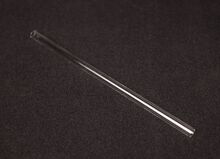The overtone flute is an old scandinavian instrument that has influenced the folk music in many places by its special sound
and scale. You can also find this flute in other countries like Hungary.
In order to make it easy for beginners, the flute should be played with a covered half-tone hole, so that just one hand movement is necessary. (This is also the shape in which the flute is delivered.)
You can regulate the tone height in two different ways. The first possibility – which gave name to the flute, – is to vary the blowing intensity in a weak or strong manner. If you blow softly, you will receive a very low tone which is the fundamental tone of the flute. When you blow more intensively, higher tones will spring up in the rising scale and a so called overtone or natural tone scale will result.
The position of the tones in the scale depends on the length of the flute. (must be done with the half-tone hole covered.) To enease the
hitting of the note desired, begin blowing with a little ”t”.
Auris-overtone flutes are tuned in d and f and gives the opportunity for beautyful duets played on the two flutes together, also in the musical games and improvisations of beginners.
Another possibility of tone variation is to alternately close and open the orifice. When you cover the orifice, you will find that the tone rises or sinks to a position in the above mentioned scale between two tones. This will happen without taking into consideration the momentary position of the tone. Thereby the number of tones can be doubled. (fig. 3)
The same quantity of tones can be received again by putting a finger into the orifice of the flute. Then the tone rises up against half a tonestep, related to the above discribed interface tone on condition that the orifice is well covered.(FIG.5)
The half-tone should be played with the thumb (fig.4 ). When the thumb hole and the orifice are open the tone rises half a tone in proportion to the tones in the fundamental scale of the flute (overtone scale).
The tones can also be "stretched" by gradualy opening and closing the holes.
To fully control the flute one has to practise to simultaniousely cover the half tone hole – open, close and putting the index finger into the orifice (fig 4 and 5) The fact that the melodies are made by varying the blowing intensity has a unique reaction on breathing and by that on the whole human being.
Bild saknas








